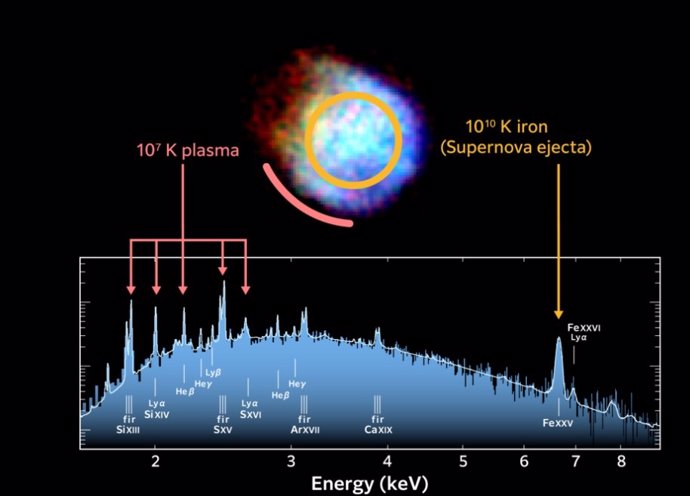Red-hot iron in supernova remnant N132D – THAT
September 20 () –
The new XRISM space telescope has revealed the structure, motion and temperature of the material surrounding a supermassive black hole and a supernova remnant with unprecedented detail.
In the first published results One year after its launchXRISM (X-Ray Imaging and Spectroscopy Mission), a mission led by the Japan Aerospace Exploration Agency (JAXA) with participation from ESA, shows its unique capabilities to reveal the speed and temperature of hot, sputtering gas, called plasma, and the three-dimensional structures of the material surrounding a black hole and an exploded star.
“These new observations provide crucial information for understanding how black holes grow by capturing surrounding matter and offer new insight into the life and death of massive stars. These results demonstrate the mission’s exceptional ability to explore the high-energy universe,” he said. in a statement Matteo Guainazzi, ESA XRISM project scientist.
In one of its “first light” observations, XRISM focused on N132D, a supernova remnant located in the Large Magellanic Cloud, about 160,000 light-years from Earth. This interstellar “bubble” of hot gas was expelled by the explosion of a very massive star approximately 3,000 years ago.
Using its Resolve instrument, XRISM uncovered the structure around N132D in detail. Contrary to previous assumptions that it was a simple spherical shell, scientists found that the remnant of N132D is doughnut-shaped. Using the Doppler effect, they measured the speed at which the hot plasma in the remnant is moving toward or away from us, and established which is expanding at an apparent velocity of about 1200 km/s.
Resolve also revealed that the remnant contains iron that has an extraordinary temperature of 10 billion degrees Kelvin. The iron atoms were heated during the supernova explosion through violent shock waves that propagated inward, a phenomenon that had been predicted by theory, but never observed before.
Supernova remnants like N132D contain important clues about how stars evolve and how (heavy) elements that are essential for our life, such as iron, are generated and propagated in interstellar space. However, previous X-ray observatories They have always had difficulty revealing how the velocity and temperature of the plasma were distributed.
SUPERMASSIVE BLACK HOLE IN THE GALAXY NGC 4151
XRISM has also shed new light on the mysterious structure surrounding a supermassive black hole. Focusing on the spiral galaxy NGC 4151, located 62 million light-years away, XRISM observations offer an unprecedented view of material very close to the galaxy’s central black hole, which has a mass 30 million times that of the Sun.
XRISM captured the distribution of matter that spins and eventually falls into the black hole over a wide radius, spanning from 0.001 to 0.1 light-years, i.e. from a distance comparable to the separation between the Sun and Uranus to 100 times that.
By determining the motions of iron atoms from their X-ray signature, the scientists mapped out a sequence of structures surrounding the giant black hole: from the disk that “feeds” the black hole to the donut-shaped torus.
These findings provide a vital piece of the puzzle for understanding how black holes grow by devouring surrounding matter, according to the researchers.
Although radio and infrared observations have revealed the presence of a doughnut-shaped torus around black holes in other galaxies, XRISM’s spectroscopic technique is the first, and currently only, way to trace how gas forms and moves near the central “monster.”





![[Img #74662]](https://thelatestnews.world/wp-content/uploads/2024/12/Organisms-with-the-shortest-life-150x150.jpg)







![[Img #74662]](https://thelatestnews.world/wp-content/uploads/2024/12/Organisms-with-the-shortest-life-300x200.jpg)


Add Comment